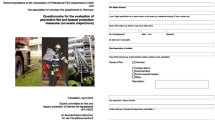Abstract
If buildings, which are designed to old prescriptive fire and building codes, are judged by current prescriptive standard, they may be considered to have “sub-standard” fire safety protection. Improvement works may be considered necessary. However, if improvement works are to be carried out at the same time, huge financial burden may be imposed on the society. Thus, prioritization of the improvement works on the basis of a holistic fire safety evaluation will even the cost burden over a period of time and maintain the fire safety in existing buildings within a reasonable level. Fire safety ranking methods have been developed in many countries to assist the evaluation of the fire safety level of buildings. Some of the methods adopting the multi-attribute evaluation approach may provide a fire safety audit from a holistic point of view. This approach can provide a simple evaluation and is particularly useful for complex multi-storey buildings.
One of the problems of using multi-attribute evaluation approach is the manipulation of the imprecise information and definition of some of the fire safety attributes. In this paper, a new reliability interval method for manipulating the weightings of attributes and a synthetic model on the basis of grey system theory is presented. The proposed method adopts the grey system theory, which is regarded as one of the methods to handle insufficient information, to establish a fire safety ranking evaluation framework.
Similar content being viewed by others
References
J.M. Watts Jr., “Fire Risk Ranking,” in SFPE Handbookss of Fire Prevention Engineering, P.J. DiNenno et al. (Eds.), Quincy, Mass.: National Fire Protection Association, 1995, pp. 5:12–5:26.
Dow Chemical Limited, Dow's Fire and Explosion Index Hazard Classification Guide, 7th edition. New York: American Institute of Chemical Engineers, 1994.
International Atomic Energy Agency, Manual for the Classification and Prioritisation of Risks Due to Major Accidents in Process and Related Industries, Vienna: International Atomic Energy Agency, 1993.
E.W. Marchant, Fire Safety Evaluation (Points) Scheme for Patient Areas within Hospitals. Report, Department of Fire Safety Engineering, University of Edinburgh, 1982.
T.J. Shield and G.W. Silcock, “Fire Safety Evaluation of Dwellings,” Fire Safety Journal, vol. 10, 1986, pp. 29–36.
NFPA101A, Guide on Alternative Approaches to Life Safety, Quincy, Mass.: National Fire Protection Association, 1995.
L.L. Parks, B.D. Kushler, M.J. Serapighlia, L.A. McKenna Jr., E.K. Budnick, and J.M. Watts, “Fire Risk Assessment for Telecommunication Central Offices,” Fire Technology, vol. 34, no. 2, 1998, pp. 156–176.
H.E. Nelson, A.J. Shibe, B.M. Levin, S.D. Thorne, and L.Y. Cooper, Fire Safety Evaluation System for National Park Service Overnight Accommodations, Gaithersburg, MD: National Bureau of Standards, NBSIR 84-2896. 1984.
S.M. Lo, “A Fire Safety Assessment System for Existing Buildings,” Fire Technology, vol. 35, no. 2, 1999, pp. 131–152.
J.M. Watts, “Fuzzy Fire Safety” Fire Technology, 1995, pp. 193–194.
S.M. Lo, B.Q. Hu, and C.Y. Yiu, “Reliability Interval Method for Weight Definition—With an Illustration in Performance Assessment for Cost Estimators,” European Journal of Operational Research (submitted).
J.L. Deng “Introduction to Grey System Theory,” Journal of Grey System, vol. 1, no. 1, 1989, pp. 1–24.
T.L. Saaty, The Analytic Hierarchy Process. New York: McGraw-Hill, 1980.
W.K. Chow, L.T. Wong, and E.C.Y. Kwan, “A Proposed Fire Safety Ranking System for Old High-Rise Buildings in Hong Kong Special Administrative Region,” Fire and Material, vol. 23, no. 1, 1999, pp. 27–31.
W.K. Chow and C.H. Lui, “A Proposed Fire Safety Ranking System for Karaoke Establishments and its Comparison with the NFPA – Fire Safety Evaluation System,” Building and Environment, vol. 37, 2002, pp. 647–656.
BSI, Fire Safety Engineering, BS ISO/TR 13387, British Standards Institution, London.
Y.P. Huang and C.C. Huang, “The Integration and Application of Fuzzy and Grey Modeling Methods,” Fuzzy Sets and Systems, vol. 78, 1996, 107–119.
R.E. Moore, Method and Application of Interval Analysis. Philadelphia, USA: SIAM, 1979.
G.H. Huang, B.W. Baety, and G.G. Partry, “A Grey Fuzzy Linear Programming Approach for Municipal Solid Waste Management Planning under Uncertainty,” Civil Engineering Systems, vol. 10, 1993, pp. 123–146.
X.M. Wang, Z.K. Chen, C.Z. Yang, and Y.M. Chen, “Grey Predicting Theory and Application of Energy Consumption of Building Heat-Moisture System,” Building and Environment, vol. 34, 1999, pp. 417–420.
J. Xia and B.Q. Hu, Water-Related Environmental Problems and Sustainability of a Case Study of the San Hua Region of China, IAHS Publication No. 240, 1997.
B.Q. Hu and M.Y. Shen, “The Translational Incidence Degree and its Applications,” Systems Engineering—Theory & Practice, vol. 4, 2000, pp. 107–110 (in Chinese).
J. Xia, “Research on Grey Correlative Assessment of Region Water Environmental Quality,” Hydrology, vol. 2, 1995, pp. 4–10 (in Chinese).
Author information
Authors and Affiliations
Corresponding author
Rights and permissions
About this article
Cite this article
Lo, S.M., Hu, B.Q., Liu, M. et al. On the Use of Reliability Interval Method and Grey Relational Model for Fire Safety Ranking of Existing Buildings. Fire Technol 41, 255–270 (2005). https://doi.org/10.1007/s10694-005-3732-9
Published:
Issue Date:
DOI: https://doi.org/10.1007/s10694-005-3732-9




